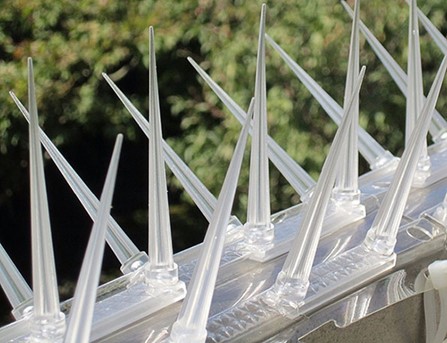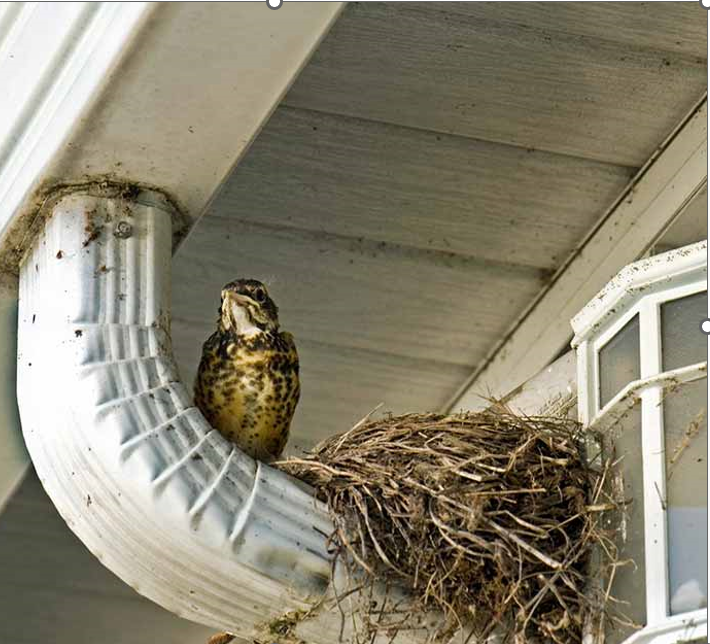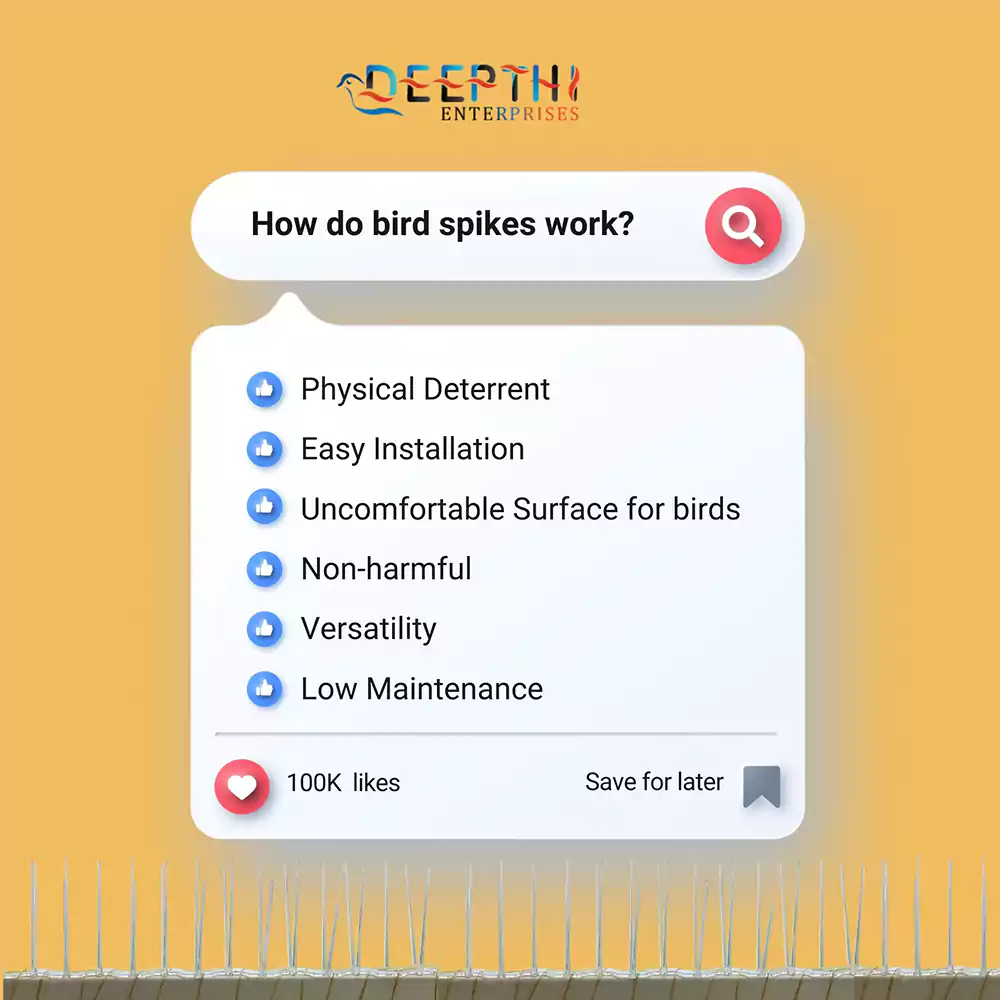Updated on Saturday, January 20, 2024
What are bird spikes?
Bird spikes are an effective and humane way to deter birds from landing and nesting on buildings and structures. The spikes create an uneven surface that birds find uncomfortable to land on, which discourages them from settling in the treated area.
Bird spikes are particularly effective for larger birds such as pigeons, seagulls, and crows, and can be used in both residential and commercial settings. They also low maintenance and provide a long-lasting solution for keeping birds away from specific areas.
One of the main advantages of Plastic bird spikes is that they are a humane method of bird control, as they do not harm the birds but simply deter them from landing in a particular area and it is cost-effective solution. This makes them a popular choice for bird control in urban environments where the goal is to reduce the impact of birds on buildings and structures without causing harm to the birds themselves.
.jpg)

Pigeon prevention spikes, often simply referred to as bird spikes, are a popular and effective method for deterring pigeons from building structures.
Bird spikes can be used in various application areas to deter birds from perching or roosting. Some common application areas include:
• Ledges
• window sills
• Outdoor AC Unit
• solar panels
• Gutters and downspouts
• chimneys
• parapets
• Outdoor Lights
• towers
• Edges
• I-beams
• Overhangs
• Pipes
• Signs and Billboards
• Street Lights and Utility Poles
• Railings
• balconies
• roof edges
• and other surfaces of residential homes
• Outdoor CCTV Camera


How do bird spikes work?
Bird spikes work by creating a physical barrier that prevents birds from landing or roosting on surfaces. The sharp prongs make it uncomfortable to land or perch on the surface, so they are discouraged from doing so.

When to Use Bird Spikes:
Bird spikes should be used in areas where birds are causing problems, such as roosting, nesting, or leaving droppings. Common areas where bird spikes are used include building ledges, rooftops, signs, windowsills, and more.
Where to Use Bird Spikes:
Bird spikes can be used in both residential and commercial settings. They are commonly used in urban areas to prevent damage to buildings and structures, as well as to reduce health hazards associated with bird droppings.

Types:
Plastic - Plastic pigeon spikes are typically made from a strong and durable polycarbonate material
Color:
• Clear or transparent: This is designed to be less visible and blend in with any background.
• Black: This color is often used on darker surfaces or in areas where visibility is not a concern.
• Grey: This is a neutral color that can blend in with many different surfaces.
• Brown: This color is often used on wooden surfaces or in natural environments to mimic the appearance of branches.
• Green
• Yellow
Choosing the Right Bird Spikes:
Species:
Consider the species of birds causing the problem. Different birds have different landing behaviors, which may influence the type of spikes needed.
Surface:
Determine the type of surface where the spikes will be installed. Some spikes are better suited for certain surfaces (e.g., narrow or wide ledges).
Coverage:
Measure the area that needs protection to calculate how many spikes or strips you'll need. Spikes should cover the entire area to be effective.
Aesthetics:
Consider the visual impact of the spikes. Plastic spikes may be less visible
How to Install Bird Spikes:
1. Clean the Surface: Before installing bird spikes, clean the surface where they will be installed to remove any dirt, debris, or bird droppings.
2. Measure the Area: Measure the area where the bird spikes will be installed to determine how many spikes are needed.
3. Prepare the Spikes: Some spikes come in strips that can be cut to the desired length. Others may require assembly.
4. Install the Spikes: Bird spikes can be installed using adhesive, screws, or clips, depending on the surface.
5. Spacing: Ensure the spikes are spaced closely enough together to prevent birds from landing between them.
6. Maintain the Spikes: Periodically check the bird spikes to ensure they are secure.
It's important to note that bird spikes may not be suitable for all bird species or situations. In some cases, alternative bird control methods, such as bird netting may be more appropriate.

Pros of Bird Spikes
• Easy to install glue, screw, or tie down
• Low-visibility deterrents
• Cost-Effective
• Low Maintenance
• humane way to deter birds
• durable and long-lasting
FAQs:
Are bird spikes effective?
Yes, bird spikes are generally considered to be effective for deterring birds from perching or nesting on buildings and structures. The spikes create an uneven surface that birds find uncomfortable to land on, which discourages them from settling in the treated area. Bird spikes are particularly effective for larger birds such as pigeons, seagulls, and crows.
Bird spikes are a popular and humane method of bird control, as they do not harm the birds but simply deter them from perching or nesting in the treated area. They are also low maintenance and provide a long-lasting solution for keeping birds away from specific areas
how much does it cost for pigeon spikes?
Plastic pigeon spikes price can start at around Rs. 30 per piece
Do pigeon control spikes work?
Yes. Pigeon control spikes are a humane way to deter pigeons and other birds from perching, roosting, or nesting on buildings and structures. They are designed to create an uneven surface that birds find uncomfortable to land on, which discourages them from settling in the treated area
Can bird spikes harm birds or other animals?
No, bird spikes are specifically designed to be humane and harmless. They act as a deterrent by making surfaces uncomfortable, but they do not cause harm to birds or other creatures.
To know more about bird spikes and its price: Click Here



